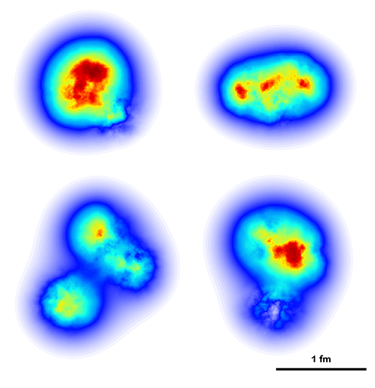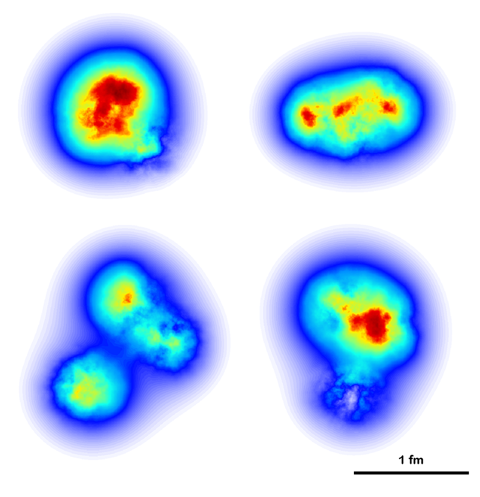Of Gluons and Fireflies
Gluons—the carriers of the strong force that “glues” quarks together—make up over 95% of the mass of you, me, and everything else in the visible Universe. But they do not exist in matter in the same way as an electron, a quark, or indeed a chair does. What matter actually is depends on the scale at which one looks at it. For example, a proton probed at low energies, which correspond to long time scales, can be seen as a collection of three quarks: two up quarks and one down quark. But on shorter time scales, one of a proton’s quarks may emit a gluon that exists for a short time before it gets absorbed by another quark. On time scales shorter than its lifetime, the gluon may further split up into gluon pairs that are quickly absorbed by another gluon. And so on. In other words, gluons are virtual particles, flickering in and out of existence much like fireflies light up on a summer night. Heikki Mäntysaari and Björn Schenke from Brookhaven National Laboratory, New York, have developed a technique for modeling such gluon fluctuations within protons that will help to measure this fundamental phenomenon in the near future [1].
Measuring gluon fluctuations requires particle collisions that include gluons and accelerate particle beams to high energies, such that the short time scales of the fluctuations can be resolved. However, this is a hard task because most interactions that involve gluons do not depend on their fluctuations. They depend only on other gluon properties averaged over longer periods of time. But there is one interaction called incoherent diffraction that directly varies with gluon fluctuations. This involves the diffraction of gluons from protons (or nuclei) and ensuing fragmentation of the protons. It is a challenging interaction to measure. The proton fragments travel in the same direction as the proton beam from which they derive. This proton beam and a counterpropagating electron beam are accelerated in a metal pipe by magnets and made to collide inside a structure that comprises several detectors surrounding the collision point. The fragments thus end up extremely close to the accelerator pipe, leaving little space in which to place a dedicated proton-fragment detector.
The experiments H1 and ZEUS at the HERA collider in Germany have previously detected incoherent diffraction in high-energy electron-proton collisions [2, 3], although researchers have not attempted to extract gluon fluctuations from these data until now. Also, heavy-nuclei collider experiments, such as the Relativistic Heavy Ion Collider in the US and the Large Hadron Collider in Europe, observe collective particle phenomena that strongly depend on gluon fluctuations (see Ref. [4] and references therein). These heavy-nuclei experiments recreate conditions that existed shortly after the big bang. But the results rely on theoretical models in which nuclear gluon fluctuations enter as a parameter that is not well constrained by the data. Having a better knowledge about these gluon fluctuations would help researchers to better understand heavy-nuclei collisions as well as early-Universe cosmology. The situation may change with the upcoming Electron Ion Collider (EIC) [5, 6], a high-precision particle accelerator that is planned for construction in the US within the next decade. The experiment will collide electrons with protons and heavy nuclei and will have dedicated detectors to measure incoherent diffraction. Researchers will, for the first time, be able to measure gluon fluctuations—directly and with high precision.
Theory and experiment go hand in hand, and with the expected precision of the EIC, theorists too have to sharpen their tools. This is exactly what Mäntysaari and Schenke did in their study. The researchers used two models of the strong force to simulate gluon fluctuations [7, 8]. These models are derived from an effective theory for the strong force called the color glass condensate theory [9], and they are known to successfully describe the HERA data that depend on the average gluon distribution in protons. One of the models inherently contains gluon fluctuations, whereas the other does not. Mäntysaari and Schenke supplemented both models with two kinds of interdependent fluctuations. First, the gluons are distributed in space in a cloud that surrounds the three quarks of the proton, following a Gaussian distribution. Second, the positions of the individual quarks also follow a Gaussian distribution around the center of the proton. Using these models, the authors demonstrate that they can tune the amount of gluon fluctuation around the quarks such that they describe the incoherent diffraction data from the HERA experiments while keeping the description of the average gluon distribution intact.
What the researchers found is that strongly fluctuating gluons are needed to fit the data. The fluctuations of the model that has built-in fluctuations were far from enough to do the job. We know that, on average, a proton is about one femtometer in size. But the comparison of the models to the HERA incoherent diffraction data indicates that protons are very different at high energies, with a width of half a femtometer for the distribution of the position of the individual quarks and an extra variation of 15% on the proton size for the gluon clouds around the quarks (Fig. 1). This means that the EIC will be able to measure protons that are 10 times larger than normal, or more. However, it would be interesting to see whether the results are model independent. One way to test this would be to add fluctuations to models other than those derived from the color glass condensate theory—a challenge for theorists.
Mäntysaari and Schenke’s results also pose a challenge to the experimental community. It is a strength of the EIC that it will collide electrons with both protons and several species of heavy nuclei. Incoherent diffraction will occur in both cases. If researchers could get a handle on gluon fluctuations within the nucleons, they would be able to separate the fluctuations of nucleon positions and those of gluons within and around nucleons, since the final result would depend on the sum of all kinds of fluctuations. This would settle a long debate on whether a heavy nucleus should be viewed as a bag of nucleons, each with a Gaussian distribution of gluons, or as a different type of hadronic object all together, with its own gluon distribution.
For heavy nuclei, it has been demonstrated that a detector can be placed behind the bend of the beam pipe to pick up the nuclear remnants, which will largely consist of neutrons and will enable incoherent diffraction to be measured. The detection of the proton’s fragments remains an outstanding challenge in terms of detector design and location because the remnants would come out even closer to the beam pipe and consist of a swath of different particles. Both types of measurements will be crucial to disentangle the different contributions to the fluctuation of gluons in matter, with a view to understanding whether they come primarily from fluctuations within nucleons or from fluctuations of nucleon positions, or a combination of the two—or something completely different. There will be an intensive research effort to finalize the design of the detectors for the EIC over the next few years. Mäntysaari and Schenke’s study represents an important contribution to this endeavor.
This research is published in Physical Review Letters.
References
- H. Mäntysaari and B. Schenke, “Evidence of Strong Proton Shape Fluctuations from Incoherent Diffraction,” Phys. Rev. Lett. 117, 052301 (2016).
- S. Chekanov et al. (ZEUS Collaboration), “Measurement of Proton-Dissociative Diffractive Photoproduction of Vector Mesons at Large Momentum Transfer at HERA,” Eur. Phys. J. C 26, 389 (2003).
- A. Aktas et al. (H1 Collaboration), “Diffractive Photoproduction of J/𝜓 Mesons with Large Momentum Transfer at HERA,” Phys. Lett. B 568, 205 (2003).
- K. Dusling, W. Li, and B. Schenke, “Novel Collective Phenomena in High-Energy Proton–Proton and Proton–Nucleus collisions,” Int. J. Mod. Phys. E 25, 1630002 (2016).
- A. Accardi et al., “Electron Ion Collider: The Next QCD Frontier—Understanding the Glue that Binds Us All,” arXiv:1212.1701.
- E. C. Aschenauer et al., “eRHIC Design Study: An Electron-Ion Collider at BNL,” arXiv:1409.1633.
- H. Kowalski, L. Motyka, and G. Watt, “Exclusive Diffractive Processes at HERA Within the Dipole Picture,” Phys. Rev. D 74, 252301 (2006).
- B. Schenke, P. Tribedy, and R. Venugopalan, “Fluctuating Glasma Initial Conditions and Flow in Heavy Ion Collisions,” Phys. Rev. Lett. 108, 252301 (2012).
- F. Gelis, E. Iancu, J. Jalilian-Marian, and R. Venugopalan, “The Color Glass Condensate,” Annu. Rev. Nucl. Part. Sci. 60, 463 (2010).





